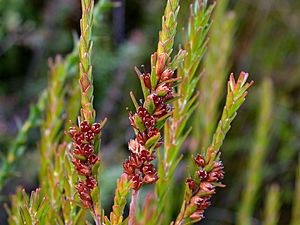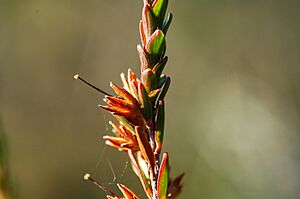Epacris corymbiflora facts for kids
Quick facts for kids Epacris corymbiflora |
|
|---|---|
 |
|
| Epacris corymbiflora during the late stages of flowering at Mt Field, Tasmania | |
| Scientific classification | |
| Genus: |
Epacris
|
| Species: |
corymbiflora
|
The Epacris corymbiflora, also known as straggling heath, is a fascinating plant that belongs to the heath family, called Ericaceae. It's a small, upright shrub with soft, green, diamond-shaped leaves. Its white, tube-shaped flowers grow together in a tight, round cluster. This special plant is found only in Tasmania, Australia's island state, growing in areas with heath plants and along the coast.
Contents
What Does Straggling Heath Look Like?
This small shrub usually grows to be about 10 to 40 centimeters tall, which is roughly the height of a ruler. It has branches that spread out. Its leaves are close to the stem and are shaped like diamonds, staying green on both sides. You can see a few parallel lines, like tiny veins, on the leaves.
The Flowers of Epacris corymbiflora
The flowers are narrow, white, and shaped like tubes. They have shiny brown parts called bracts and sepals at their base. These flowers grow in special clusters called corymbs on short stalks. A corymb is a flower cluster where the lower flowers have longer stems, making the whole cluster look flat or slightly rounded at the top. These clusters form a dense, round group, which is quite unique! After the flowers, the plant produces small seed pods, called capsules.
Growing Straggling Heath at Home
Epacris corymbiflora can grow well in pots or containers because it's a naturally small plant. If you want to grow it from seeds, some seeds need to be stored in a dark place for 3 to 6 months first. This helps them get ready to sprout.
If you use a special planting method called the "bog method," you should sprinkle the seeds on top of the soil mix. If you keep the soil constantly moist, the seeds should start to grow within 10 to 20 weeks.
How Did Straggling Heath Get Its Name?
The scientific name Epacris corymbiflora tells us a bit about the plant. It belongs to the heath family, Ericaceae, and a group within that family called Epacridoideae, which is common in Australia.
Understanding the Name Epacris
The first part of the name, Epacris, comes from two ancient Greek words: 'epi', meaning "upon," and 'akros', meaning "the top." This might refer to where the plant grows or how its flowers appear.
Understanding the Name Corymbiflora
The second part, corymbiflora, comes from the word 'corymb'. As we learned, a corymb describes flower clusters that form a flat or slightly rounded top because the lower flower stalks are longer. The word 'corymb' itself came into use around the early 1700s, either from the French word corymbe or the Latin word corymbus, which originally came from the Greek word korumbos, meaning "cluster." Scientists have known about Epacris corymbiflora since at least 1860.
Where Does Straggling Heath Live?
Epacris corymbiflora is found in heath areas and along the coast of Tasmania. It especially likes wet, peaty heathlands near the west and southwest coasts, like in the Rasselas Valley.
What Kind of Environment Does It Like?
This plant prefers moist soils that are light to medium in texture and rich in organic matter, like decaying leaves. It also likes places with some dappled shade, meaning it gets a mix of sun and shade.
It's a tough plant that can handle windy conditions, as long as there's plenty of moisture. It can even grow in clay or peaty soils that don't drain very well and might not be very rich in nutrients.
Images for kids




